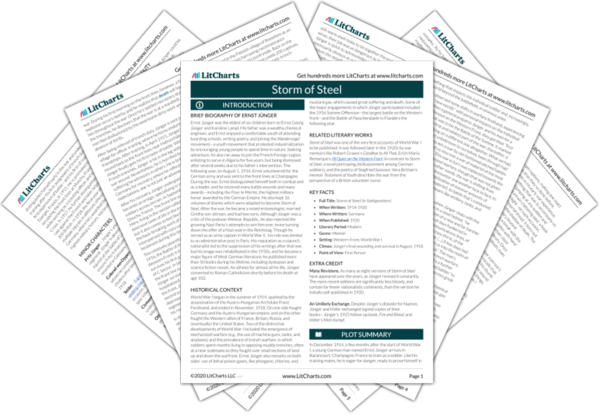Summary
Analysis
By May 1917, Jünger’s unit is back on the Siegfried Line, which they’d left just a month earlier. By this time, Jünger barely notices the shrapnel or shells, which just seem to him like another sign of spring—a new offensive is on the way. The coming weeks are fairly peaceful; Jünger even enjoys a “summer holiday” reading Ariosto in a rural village.
The “Siegfried Line” shouldn’t be confused with the German defensive line of World War II. The Siegfriedstellung, or Siegfried Position, was constructed along the Western Front in 1916-1917 with the hope of delaying an Allied offensive. Jünger’s version of manliness isn’t solely based in military conquest or physical strength—rather, he always makes room for enjoying literary pleasures when he can, and here appreciates the Renaissance-era Italian epic poet Ariosto.
Themes
In late May, the company occupies a large estate behind the front line, the base for several machine-gun nests. Jünger explains that such support-points were the war’s first attempts “at a more supple, variable form of defense.” Jünger enjoys evening strolls around the farm, admiring nature’s tenacious liveliness.
As Jünger continues to observe the development of modern warfare, he sees the German army attempting to move beyond the stasis induced by trench warfare. He continues to seek out signs of life amidst the barrenness of war, showing that he made a concerted effort to stay in touch with his humanity in the midst of battle.
Themes
On May 30, Jünger rejoins his old 2nd Company on the front line. The British gunners aren’t very skilled, and at first, it’s a relatively quiet time. In June, Jünger is ordered to take 20 men to an outpost on the front. Soon he joins another company on an ambush “for the hell of it.” Before long, they are surprised to encounter a group of British in the open. After a firefight and hearing some indeterminate accents in the distance, a line of attackers surprisingly emerges into the open. The Germans overpower the other group without getting a good look at them. Later, Jünger returns to the scene of the battle and discovers that the survivors are from India, the First Hariana Lancers. The encounter has the feeling of “ancient history” to Jünger. The company is later recognized for fighting off the much larger group of Lancers with only 20 men. In the midst of stalemated trench warfare, Jünger had been dreaming of just such a battle.
Jünger’s keenness for action shows that, despite his fondness for books and nature, at the same time he takes real pleasure in fighting. This also comes through in the fact that he’d been “dreaming” of an open battle like the firefight that occurs here, encountering a unit from the British Indian army. The existence of this group is a reminder of Britain’s imperial reach at the time of World War I and the superior manpower they were able to draw upon thereby—a factor that will come up later in the war, too. At the time, it gives Jünger an uncanny feeling of the clash of civilizations; the war truly spans the globe like no war has before.
Themes
Later that month, their outpost is attacked again, and Jünger’s unit loses a machine-gun, which they ultimately fail to regain. After Jünger’s men are relieved by troops from another division, the outpost is ultimately lost.
This sequence of events shows how quickly fortunes reversed along the Western Front, and how many lives were spent in pursuit of short-lived, dubious victories.
Themes
Get the entire Storm of Steel LitChart as a printable PDF.













